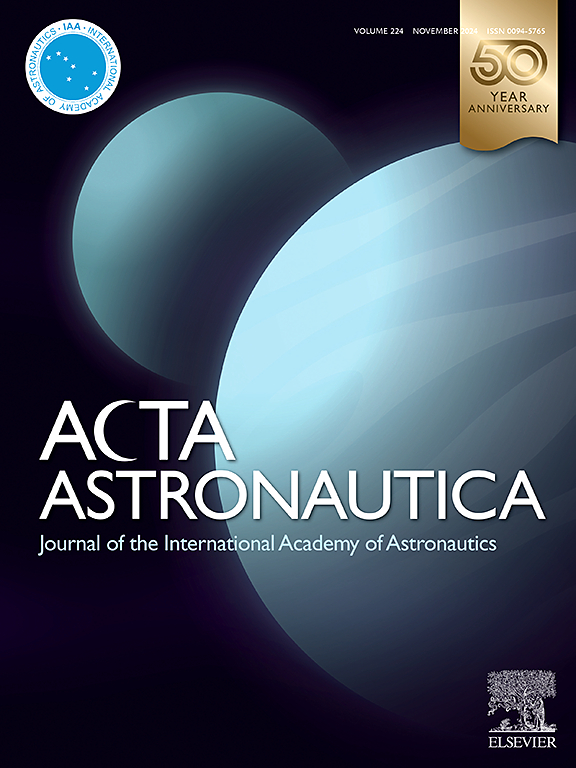Study on parastronaut ingress and egress of orion and boeing CST-100 starliner space vehicles
IF 3.4
2区 物理与天体物理
Q1 ENGINEERING, AEROSPACE
引用次数: 0
Abstract
This preliminary investigation aimed to observe individuals with disabilities participating in the ingress and egress procedures of Lockheed Martin's Orion and Boeing's CST-100 Starliner spacecraft. Motivated by the aspiration for inclusivity in space programs and the introduction of the first parastronaut within the European Space Agency (ESA), NASA funded the present study, which utilized motion capture and video analysis to study the entry and exit processes in detail. Data encompassed total time taken, phase interval duration, steps executed, missed steps, and various kinematic factors related to balance during walking. The study comprised eight participants: three fully-abled individuals formed the control group and five with leg amputations formed the experimental group. Among the experimental group, there were two individuals with left leg amputations, both below the knee; two with right leg amputations, one above the knee and one below the knee; and one individual with bilateral above-knee amputations.
Several significant findings emerged from the analysis. Firstly, it was observed that, on average, the experimental group could complete egress from the capsule environments in less than 50 s. Secondly, on average, the experimental group took 7.7 s longer than the control group to complete ingress and 9.19 s longer to complete egress. Notably, the experimental group utilized more balancing mechanisms during ingress and egress procedures.
The data indicated that individuals with lower limb deficiency should feasibly enter and exit the capsule environment safely within 60 s. However, it was observed that these processes required more movements, suggesting compensation for the mobility limitations of prosthetics. Despite slight variations in mobility sequencing, participants with prosthetic limbs completed the tasks within acceptable timeframes. They adeptly navigated through unfamiliar environments without tripping or colliding with any elements. Notably, the participants were novices to the capsule environment, indicating that highly trained parastronauts should be capable of safely entering and exiting the environment.
猎户座和波音CST-100星际飞船的伞兵出入研究
这项初步调查旨在观察参与洛克希德·马丁公司“猎户座”和波音公司CST-100“星际飞船”飞船进出过程的残疾人。出于对空间项目包容性的渴望和在欧洲航天局(ESA)内引进第一位伞员的动机,美国宇航局资助了本研究,该研究利用动作捕捉和视频分析来详细研究进入和退出过程。数据包括所花费的总时间、阶段间隔持续时间、执行的步数、错过的步数以及与行走过程中平衡相关的各种运动学因素。这项研究包括8名参与者:3名完全残疾的人组成对照组,5名腿部截肢的人组成实验组。实验组中有2人左腿截肢,均在膝盖以下;两个右腿截肢,一个膝盖以上,一个膝盖以下;还有一人双侧膝盖以上截肢。从分析中得出了几个重要的发现。首先,我们观察到,平均而言,实验组可以在不到50秒的时间内完成从胶囊环境的出口。其次,实验组比对照组平均多出7.7 s,多出9.19 s。值得注意的是,实验组在进出过程中使用了更多的平衡机制。这些数据表明,下肢障碍者在60 s内安全进出胶囊环境是可行的。然而,观察到这些过程需要更多的运动,这表明对义肢的行动限制进行了补偿。尽管在活动顺序上有细微的差异,但使用假肢的参与者都在可接受的时间范围内完成了任务。他们熟练地在陌生的环境中航行,不会绊倒或与任何元素相撞。值得注意的是,参与者都是太空舱环境的新手,这表明训练有素的伞兵应该能够安全进入和离开这个环境。
本文章由计算机程序翻译,如有差异,请以英文原文为准。
求助全文
约1分钟内获得全文
求助全文
来源期刊

Acta Astronautica
工程技术-工程:宇航
CiteScore
7.20
自引率
22.90%
发文量
599
审稿时长
53 days
期刊介绍:
Acta Astronautica is sponsored by the International Academy of Astronautics. Content is based on original contributions in all fields of basic, engineering, life and social space sciences and of space technology related to:
The peaceful scientific exploration of space,
Its exploitation for human welfare and progress,
Conception, design, development and operation of space-borne and Earth-based systems,
In addition to regular issues, the journal publishes selected proceedings of the annual International Astronautical Congress (IAC), transactions of the IAA and special issues on topics of current interest, such as microgravity, space station technology, geostationary orbits, and space economics. Other subject areas include satellite technology, space transportation and communications, space energy, power and propulsion, astrodynamics, extraterrestrial intelligence and Earth observations.
 求助内容:
求助内容: 应助结果提醒方式:
应助结果提醒方式:


